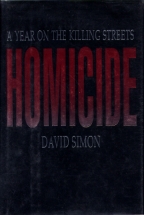Homicide: A Year on the Killing Streets
David Simon
Houghton Mifflin
US Hardcover First
ISBN 0-395-48829-X
Publication Date: 06-15-1991
599 Pages; $24.95
Date Reviewed: 12-15-03
Reviewed by: Rick Kleffel © 2003

REFERENCES
COLUMNS
|
|
|
Homicide: A Year on the Killing StreetsDavid SimonHoughton MifflinUS Hardcover FirstISBN 0-395-48829-XPublication Date: 06-15-1991599 Pages; $24.95Date Reviewed: 12-15-03Reviewed by: Rick Kleffel © 2003 |
|
|
REFERENCES |
COLUMNS |
Non-fiction need not read like non-fiction. A certain percentage of the non-fiction published can and does read as if it were a novel. True-crime stories are particularly amenable to this treatment, and we've had some true classics come out of this; Truman Capote's 'In Cold Blood' is no less than bona-fide high literature. Stories of crime are by definition compelling for most readers. We sense that there must be a strong conflict and story to carry us from the beginning to the end. David Simon's 'Homicide' can and should be elevated to the rarefied strata of bona-fide high literature. A stronger picture of American culture towards the end of the 20th century would be hard to find. Simon takes a huge canvas, narrows it down with cunning and erudition, then proceeds to unfurl a complex story with a large cast of characters who live not only on the printed page, but in real life. But it's not the real-world reality that gets to the reader and makes the work compelling, though it helps. What Simons does is to rebuild the real world as a non-fiction construct that is structured like fiction. The writing becomes as compelling to the reader as the reality of the events. Simon gets out of the way of the world he's portraying and filters it through powerful prose and re-constructive techniques. His ability to juggle the storylines and bring it all together in a single written work is nothing short of astonishing. Even now, long after it was written, it holds its appeal by virtue of being only about the time, the place and the people. From this Simon distills elements of classic literature that have universal and time-honored appeal.
In January of 1988, David Simon joined Baltimore's police department with the rank of "police intern". He was permitted to join the detectives of one shift, headed by Lieutenant Gary D'Addario. He wasn't exactly welcomed unto the unit. Most of them didn't want him there. But he persisted, kept a low profile and was quickly relegated to the background. There, he was allowed to observe real big-city detectives at work. The stories that unfold are exciting, surprising and profoundly moving. Three detectives dominate the narrative. Donald Worden is the veteran investigator, Harry Edgerton is the black cop in a mostly white unit, and Tom Pellegrini is the rookie. These are not the only people that Simon covers, but they provide the focus for his work. Simon's internal editor keeps the narrative tight, but is expansive enough to offer a kind of chaotic overview. We have heroes in this book who are given literary life by Simon's prose.
Simon's vision of the Honmicide department is different from anything else you're likely to have encountered in crime literature, films or television. Some crimes are quickly solved, but the experience of the detective is not the linear edit that we see in fiction. Instead, Simon shows us a matrix of inter-leaved single steps taken on multiple cases. It's a complex picture that clear writing brings into focus. Most of us are used to multi-tasking in our day-to-day lives. Here, Simon plays it out in the work of policemen trying to solve several crimes at once. For each step forward on any crime, there's likely to be another backward, and that's only after others both back and forth on other crimes. Simon's talent is that he make all this clear to the reader.
Writing in a novelistic style can be hazardous for the non-fiction writer, because he can strain the credibility of the reader when he portrays the thoughts of his subjects. Simon's afterward assures us that he's run all those interior monologues past all his subjects. Moreover, they're well-enough written that they seem natural, they fit in perfectly with the dialogue (again, checked with the speakers) and the action. Simon's re-constructions have the undeniable ring of truth.
Though 'Homicide' is a big book, it's a page-turning sort of read. Simon manages to bring the characters quickly into focus, make you care about them, then follows them as they plunge into the stuff of a bezillion books, movies and television shows. Having the events play out in parallel rather than serial mode quickly gives the reader insights into the personalities of the players, bringing depth and heft to the narrative. Readers who crave the police procedural need look no further. Writers who seek the reality behind that which they wish to portray can find doors opened here that they're not going to find anywhere else. Simon's vision of 1988 Baltimore offers a detailed picture of men, violence, retribution, crime and punishment in modern America that will never lose its appeal. No matter how attractive the world of fiction is, make the time to read this book. 'Homicide: A Year on the Killing Streets' is the reality of which fiction is but a dream -- or a dream within a dream.